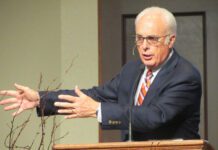The Acoustics
Most discussions about designs for assemblies focus on acoustics. When someone pays $50 or more for a theatre or symphony ticket, he or she expects to be able to hear. It should go without saying that conditions should be at least as good when the gospel’s at stake.
Too many rooms fail to facilitate the sharing of the spoken word. Others fail to encourage congregational participation. An experienced speaker can compensate for bad acoustics. He can speak a little louder or more distinctly. She can change cadence, as she might when speaking through an interpreter. A visitor who’s taken the risk of singing in a nonresponsive space can have the sense he or she is alone and may simply go away.
The art and science of acoustics have advanced sufficiently to support all forms of worship, and beg questions of theological significance. Most rooms display a kind of “platform bias.” They’re designed to reinforce whatever emanates from the front of the room. Sounds coming from the crowd are dampened and thereby devalued. It’s analogous to human experience that reinforcing and encouraging congregational singing and speech threatens the intelligibility of what’s spoken from the pulpit. Leaders (and designers) must decide how truth is preserved in a culture that values collaboration.
The Message
In a 2010 TED presentation, former Talking Heads front man David Byrne suggested that rooms not only shape the experience of speaking and hearing, but they change the nature of what’s being presented. Audiences for early opera and contemporary arenas were, and are, rowdy participants in the performance itself. Compositions had to overcome noise and chaos to be heard. Highly reverberant cathedrals gave rise to chants. Stadium concerts sired anthems. Modern MP3 players call for precise music, because of their intimacy with the audience, and a narrow dynamic range, so they don’t explode unexpectedly inside your ear.
This is not to suggest speakers are slaves to their environment or that truth is compromised, but human beings can’t help but be cognizant of their surroundings. I sit closer to my friends and change the volume of my speech in a noisy restaurant. Bumper stickers are short because of the size of bumpers and the speed of passersby. A speaker might edit an illustration, or eliminate them altogether, if he or she senses the audience is restless or overly warm.
The Hearing
Pioneers in digital media long have discussed the concept of lean forward — versus lean back — technology. The computer is regarded as the former, calling for the user to actively engage the medium. Television is considered by most to be the latter. It allows — indeed, encourages — the listener to take a passive role. The sermon is often a lean-back mechanism designed to get the listener to lean forward. The typical sermon seems to be a monologue in which one person speaks for the benefit of passive others. Many speakers, uncomfortable with that idea, encourage — or beg for — reaction from the audience by asking questions or encouraging shouted responses.
The reality is that any presentation that includes three or more people involves all of them. The speaker speaks, an audience member hears and reacts, and another audience member reacts based on what he or she hears and sees from the speaker, as well as neighbors. The speaker, in turn, tweaks his or her voice or mannerisms in response to what’s going on in the audience. This is how a television laugh track works. We validate our responses through the behavior of others in the room.
Some rooms support this kind of interaction more than others. The oldest ones, traditional cruciform plans, do a surprisingly good job of it. Linear rooms that point everyone the same direction are less effective. Somewhere in between are contemporary fan-shaped environments. The benefit is lost, however, when the room is darkened to focus only on the presenter.
Winston Churchill pointed out: “First we shape our buildings and thereafter, they shape us.” They don’t just offer a place to gather and keep us dry. They articulate our priorities and affect our hearing. In so doing, they speak.












